What Kind of Soul? Northern Soul!
Trying to define 'the origins' of Northern Soul for the uninitiated - Part 1.
If you were to search for the origins of Northern Soul, you might be surprised by what you find. Some would say it began through clubs like The Twisted Wheel in Whitworth Street in Manchester, or Stoke-on-Trent's The Torch (also called The Golden Torch).


Others would say that it was a music scene for teenagers in the North of England.
Here's a few facts you may not know (courtesy of a New Zealand Northern Soul website). Northern Soul down under??? Does that make it Southern Soul? Good question and one that is hopefully answered later for you.
- Did you know?
The Soul record guru Dave Godin first coined the phrase 'Northern Soul' sometime around 1971 when writing his column in Blues and Soul magazine. - Did you know?
To date Northern Soul and it's culture has had around 20 books published and well over 5000 compilation CD's, along with TV documentaries and Films (but please, I beg of you, don't watch the films). - Did you know?
Ebay's web site has an entire Auction section specifically for Northern Soul. - Did you know?
Billboard magazine voted the infamous Wigan Casino (1973 - 1981) "Best Disco In the World" (more about Wigan later) - Did you know?
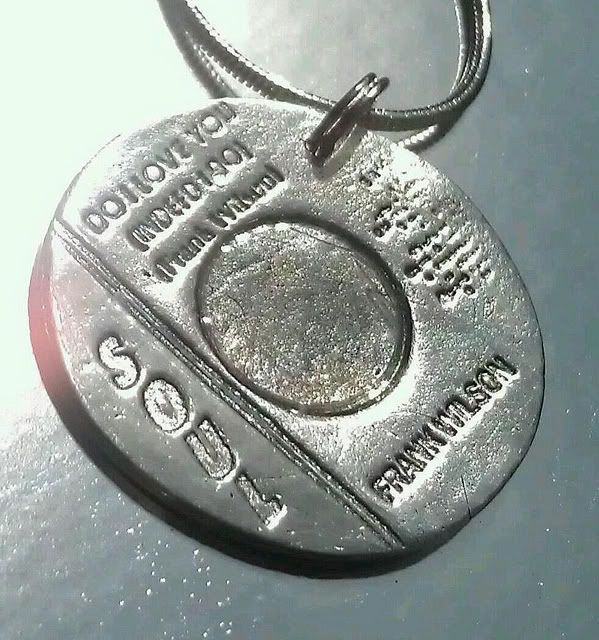 One of the highest prices paid for a 45 rpm
vinyl was £15,000 (around NZ$35,000). The record, a copy of Frank Wilson's 'Do I Love
You?', was bought in 1999 by a Scottish collector (an old mate of mine). This extremely rare and coveted disc
was pressed in the mid-1960's but never released for public listening. In May 2009 however
another copy of the same single sold for a staggering £25,742.
One of the highest prices paid for a 45 rpm
vinyl was £15,000 (around NZ$35,000). The record, a copy of Frank Wilson's 'Do I Love
You?', was bought in 1999 by a Scottish collector (an old mate of mine). This extremely rare and coveted disc
was pressed in the mid-1960's but never released for public listening. In May 2009 however
another copy of the same single sold for a staggering £25,742.
Hang on a minute, Dave Godin coined the phrase Northern Soul in 1971? The Twisted Wheel patch above shows 1963 to 1971!!! So if Northern Soul had been around since at least 1963 but it wasn't called Northern Soul, what was it called? Another good question, but let's just clear this Dave Godin thing up first via the actual mans own words.
quote: In a 2002 interview with Chris Hunt of Mojo, he explained that he had first come up with the term in 1968 as a sales reference to help staff in his shop (the infamous Soul City) differentiate the more modern funkier sounds from the smoother, Motown-influenced soul of a few years earlier (Southern Soul you may ask??):
"I had started to notice that northern football fans who were in London to follow their team were coming into the store to buy records, but they weren’t interested in the latest developments in the black American chart. I devised the name as a shorthand sales term. It was just to say ‘if you’ve got customers from the north, don’t waste time playing them records currently in the US black chart, just play them what they like - ‘Northern Soul’.
The 1971'ish reference is to do with Dave writing a column in a soul music magazine called Blues and Soul, where he added the term Northern Soul in his column and it caught on. So what was it called before that?
Well, back in the early to mid-sixties, it was a lot easier to answer that because the Northern Soul and pre-Northern Soul was a lot simpler to describe than today's Northern Soul!
Because we need to go back to the 1950's (before what became Northern Soul) to understand its true heritage - The British Mod Scene. The following excerpt can be found on Wikipedia
MOD, Mod-Beat:

Mod (from modernist) is a subculture that originated in London, England in the late 1950s and peaked in the early-to-mid 1960s.
Significant elements of the mod subculture include: fashion (often tailor-made suits); pop music, including African American soul, Jamaican ska, and British beat music and R&B; and Italian motor scooters. The original mod scene was also associated with amphetamine-fuelled all-night dancing at clubs. From the mid-to-late 1960s onwards, the mass media often used the term mod in a wider sense to describe anything that was believed to be popular, fashionable or modern.
There was a mod revival in the United Kingdom in the late 1970s, which was followed by a mod revival in North America in the early 1980s, particularly in Southern California.
Etymology

The term mod derives from modernist, which was a term used in the 1950s to describe modern jazz musicians and fans. This usage contrasted with the term trad, which described traditional jazz players and fans. The 1959 novel Absolute Beginners by Colin MacInnes describes as a modernist, a young modern jazz fan who dresses in sharp modern Italian clothes. Absolute Beginners may be one of the earliest written examples of the term modernist being used to describe young British style-conscious modern jazz fans. The word modernist in this sense should not be confused with the wider use of the term modernism in the context of literature, art, design and architecture.
History
Dick Hebdige claims that the progenitors of the mod subculture "appear to have been a group of working-class dandies, possibly descended from the devotees of the Italianite [fashion] style." Mary Anne Long disagrees, stating that "first hand accounts and contemporary theorists point to the Jewish upper-working or middle-class of London’s East End and suburbs." Sociologist Simon Frith asserts that the mod subculture had its roots in the 1950s beatnik coffee bar culture, which catered to art school students in the radical bohemian scene in London. Steve Sparks, who claims to be one of the original mods, agrees that before mod became commercialised, it was essentially an extension of the beatnik culture: "It comes from ‘modernist’, it was to do with modern jazz and to do with Sartre" and existentialism. Sparks argues that "Mod has been much misunderstood... as this working-class, scooter-riding precursor of skinheads."
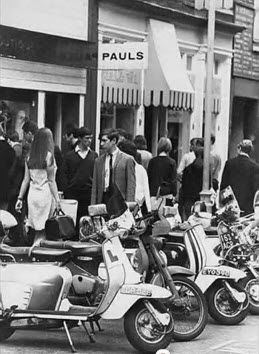
Coffee bars were attractive to youths, because in contrast to typical British pubs, which closed at about 11 pm, they were open until the early hours of the morning. Coffee bars had jukeboxes, which in some cases reserved some of the space in the machines for the students' own records. In the late 1950s, coffee bars were associated with jazz and blues, but in the early 1960s, they began playing more R&B music. Frith notes that although coffee bars were originally aimed at middle-class art school students, they began to facilitate an intermixing of youths from different backgrounds and classes. At these venues, which Frith calls the "first sign of the youth movement", youths would meet collectors of R&B and blues records, who introduced them to new types of African-American music, which the teens were attracted to for its rawness and authenticity. They also watched French and Italian art films and read Italian magazines to look for style ideas. According to Hebdige, the mod subculture gradually accumulated the identifying symbols that later came to be associated with the scene, such as scooters, amphetamine pills, and music.
Decline and Offshoots
By the summer of 1966, the mod scene was in sharp decline. Dick Hebdige argues that the mod subculture lost its vitality when it became commercialised, artificial and stylised to the point that new mod clothing styles were being created "from above" by clothing companies and by TV shows like Ready Steady Go!, rather than being developed by young people customising their clothes and mixing different fashions together.
As psychedelic rock and the hippie subculture grew more popular in the United Kingdom, many people drifted away from the mod scene. Bands such as The Who and Small Faces had changed their musical styles and no longer considered themselves mods. Another factor was that the original mods of the early 1960s were getting into the age of marriage and child-rearing, which meant that they no longer had the time or money for their youthful pastimes of club-going, record-shopping and scooter rallies. The peacock or fashion wing of mod culture evolved into the swinging London scene and the hippie style, which favored the gentle, marijuana-infused contemplation of esoteric ideas and aesthetics, which contrasted sharply with the frenetic energy of the mod ethos.
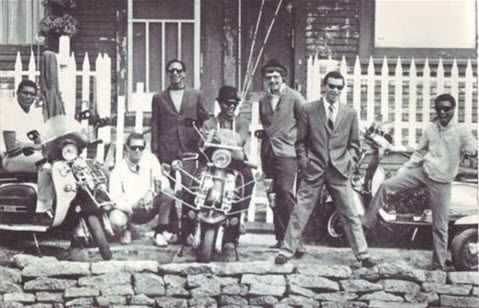
The hard mods of the mid-to-late 1960s eventually transformed into the skinheads. Many of the hard mods lived in the same economically depressed areas of South London as West Indian immigrants, and those mods emulated the rude boy look of pork pie hats and too-short Levis jeans. These "aspiring 'white negros'" listened to Jamaican ska and mingled with black rude boys at West Indian nightclubs like Ram Jam, A-Train and Sloopy's.

Dick Hebdige claims that the hard mods were drawn to black culture and ska music in part because the educated, middle-class hippie movement's drug-oriented and intellectual music did not have any relevance for them. He argues that the hard mods were also attracted to ska because it was a secret, underground, non-commercialised music that was disseminated through informal channels such as house parties and clubs. The early skinheads also liked soul, rocksteady and early reggae.
The early skinheads retained basic elements of mod fashion — such as Fred Perry and Ben Sherman shirts, Sta-Prest trousers and Levi's jeans — but mixed them with working class-oriented accessories such as braces and Dr. Martens work boots. Hebdige claims that as early as the Margate and Brighton brawls between mods and rockers, some mods were seen wearing boots and braces and sporting close cropped haircuts, which "artificially reproduces the texture and appearance of the short negro hair styles" (though this was as much for practical reasons, as long hair was a liability in industrial jobs and streetfights).
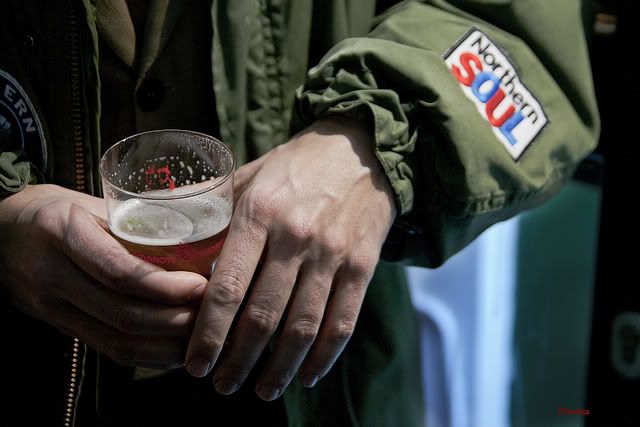
Mods and ex-mods were also part of the early northern soul scene, a subculture based on obscure 1960s and 1970s American soul records. Some mods evolved into, or merged with, subcultures such as individualists, stylists, and scooterboys, creating a mixture of "taste and testosterone" that was both self-confident and streetwise.
Revival and later influences
A mod revival started in the late 1970s in the United Kingdom, with thousands of mods attending scooter rallies in places like Scarborough and the Isle of Wight. This revival was partly inspired by the 1979 film Quadrophenia and by mod-influenced bands such as The Jam, Secret Affair, Purple Hearts and The Chords. Many of the mod revival bands were influenced by the energy of British punk rock and New Wave music. The British revival was followed by a mod revival in North America in the early 1980s, particularly in Southern California, led by bands such as The Untouchables. The mod scene in Los Angeles and Orange County was partly influenced by the 2 Tone ska revival in England, and was unique in its racial diversity, with black, white, Hispanic and Asian participants. The 1990s Britpop scene featured noticeable mod influences on bands such as Oasis, Blur, Ocean Colour Scene and The Verve.

Characteristics
Paul Jobling and David Crowley argue that the concept of mod can be difficult to pin down, because throughout the subculture's original era, it was "prone to continuous reinvention." They claim that since the mod scene was so pluralist, the word mod was an umbrella term that covered several distinct sub-scenes. Terry Rawlings' history of the mod subculture argues that mods are difficult to define because the subculture started out as a "mysterious semi-secret world", which The Who's manager Peter Meaden summarised as "clean living under difficult circumstances." Dick Hebdige points out that when trying to understand 1960s mod culture, one has to try and "penetrate and decipher the mythology of the mods".
Terry Rawlings argues that the mod scene developed when British teenagers began to reject the "dull, timid, old-fashioned, and uninspired" British culture around them, with its repressed and class-obsessed mentality and its "naffness". Mods rejected the "faulty pap" of 1950s pop music and sappy love songs. They aimed at being "cool, neat, sharp, hip, and smart" by embracing "all things sexy and streamlined", especially when they were new, exciting, controversial or modern. Hebdige claims that the mod subculture came about as part of the participants' desire to understand the "mysterious complexity of the metropolis" and to get close to black culture of the Jamaican rude boy, because mods felt that black culture "ruled the night hours" and that it had more streetwise "savoir faire". Shari Benstock and Suzanne Ferriss argue that at the "core of the British Mod rebellion was a blatant fetishising of the American consumer culture" that had "eroded the moral fiber of England." In doing so, the mods "mocked the class system that had gotten their fathers nowhere", and created a "rebellion based on consuming pleasures" ranging from Italian suits and scooters to US soul records.
Fashion

Jobling and Crowley called the mod subculture a "fashion-obsessed and hedonistic cult of
the hyper-cool" young adults who lived in metropolitan London or the new towns of the south.
Due to the increasing affluence of post-war Britain, the youths of the early 1960s were one
of the first generations that did not have to contribute their money from after-school jobs
to the family finances.
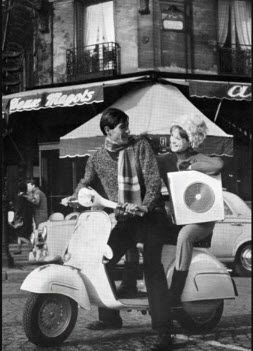 As mod teens and young adults began using their disposable income
to buy stylish clothes,the first youth-targeted boutique clothing stores opened in London
in the Carnaby Street and Kings Road districts.Maverick fashion designers emerged, such
as Mary Quant, who was known for her increasingly short miniskirt designs, and John Stephen,
who sold a line named "His Clothes", and whose clients included bands such as Small Faces.
As mod teens and young adults began using their disposable income
to buy stylish clothes,the first youth-targeted boutique clothing stores opened in London
in the Carnaby Street and Kings Road districts.Maverick fashion designers emerged, such
as Mary Quant, who was known for her increasingly short miniskirt designs, and John Stephen,
who sold a line named "His Clothes", and whose clients included bands such as Small Faces.
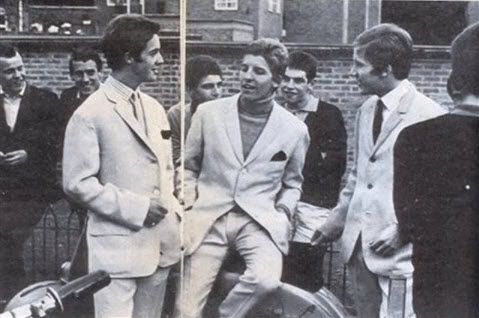

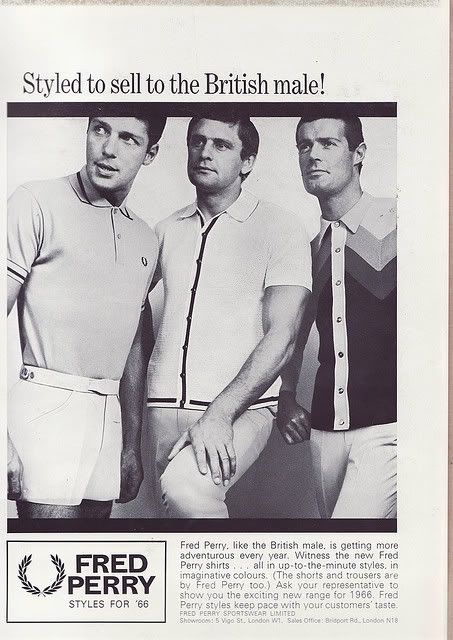
Two youth subcultures helped pave the way for mod fashion by breaking new ground; the beatniks, with their bohemian image of berets and black turtlenecks, and the Teddy Boys, from which mod fashion inherited its "narcissitic and fastidious tendencies" and the immaculate dandy look. The Teddy Boys paved the way for making male interest in fashion socially acceptable, because prior to the Teddy Boys, male interest in fashion in Britain was mostly associated with the underground homosexual subculture's flamboyant dressing style.
Clubs, Music, and Dancing
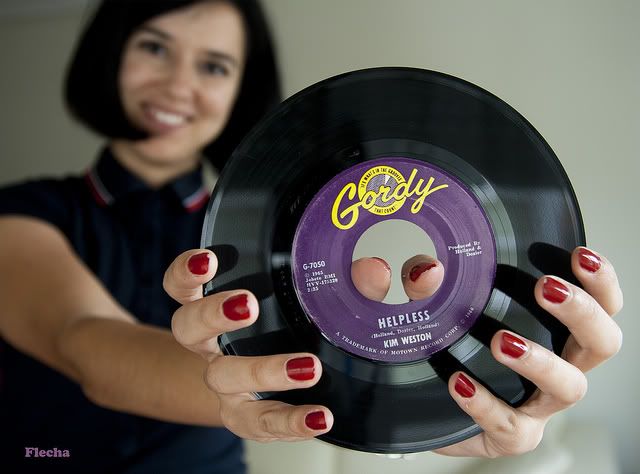
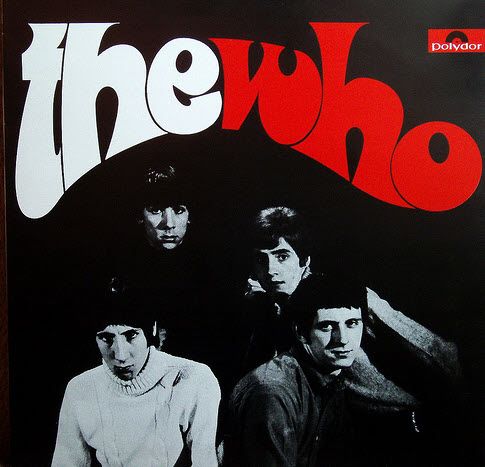
The original mods gathered at all-night clubs such as The Roaring Twenties, The Scene,
La Discothèque, The Flamingo and The Marquee in London to hear the latest records and
to show off their clothes and dance moves. As mod spread across the United Kingdom,
other clubs became popular such as Twisted Wheel Club in Manchester. They began listening
to the "sophisticated smoother modern jazz" of Dave Brubeck and the Modern Jazz Quartet."
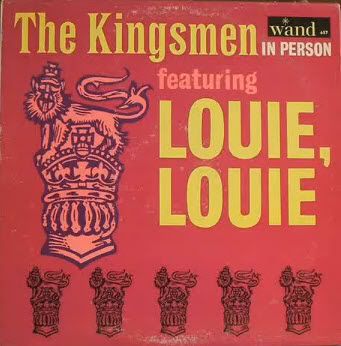 They became "...clothes obsessed, cool, dedicated to R&B and their own dances." Black
American servicemen, stationed in the Britain during the Cold War, also brought over
rhythm and blues and soul records that were unavailable in Britain,
They became "...clothes obsessed, cool, dedicated to R&B and their own dances." Black
American servicemen, stationed in the Britain during the Cold War, also brought over
rhythm and blues and soul records that were unavailable in Britain,
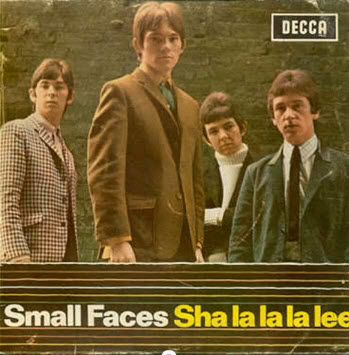 and they often
sold these to young people in London. Although the Beatles dressed "mod" in their early
years, their beat music was not popular among mods, who tended to prefer R&B based bands
like Small Faces, The Kinks, The Yardbirds and particularly The Who.
and they often
sold these to young people in London. Although the Beatles dressed "mod" in their early
years, their beat music was not popular among mods, who tended to prefer R&B based bands
like Small Faces, The Kinks, The Yardbirds and particularly The Who.
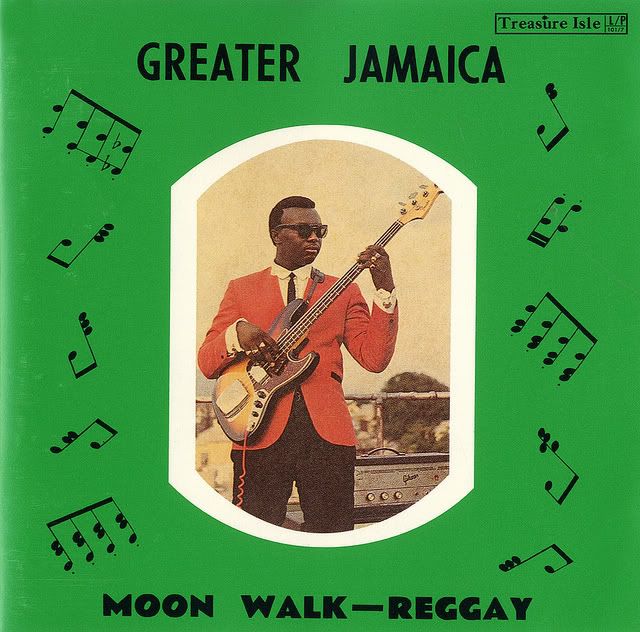
The influence of British newspapers on creating the public perception of mods as having
a leisure-filled clubgoing lifestyle can be seen in a 1964 article in the Sunday Times.
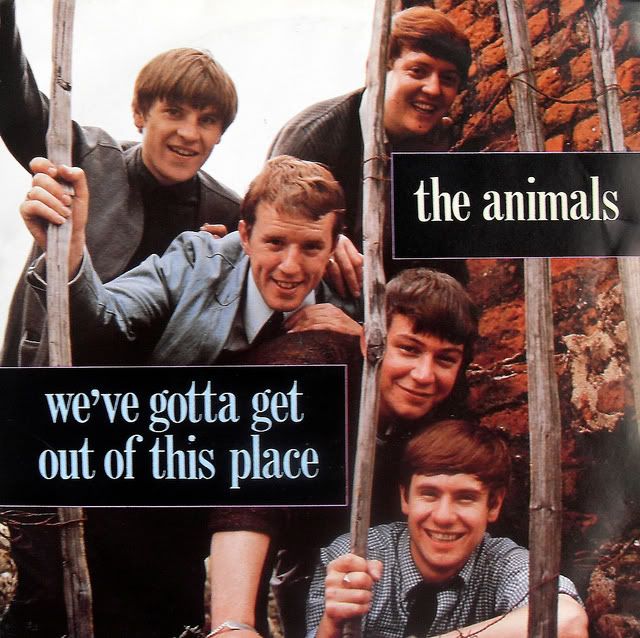 The paper interviewed a 17-year-old mod who went out clubbing seven nights a week and
spent Saturday afternoons shopping for clothes and records. However,
The paper interviewed a 17-year-old mod who went out clubbing seven nights a week and
spent Saturday afternoons shopping for clothes and records. However,
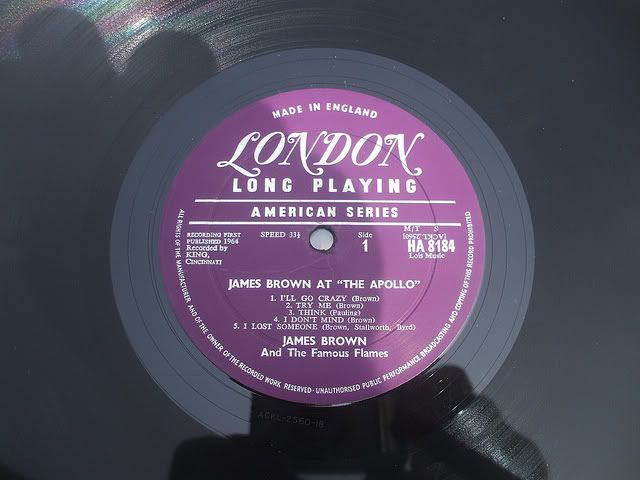 few British teens
and young adults would have the time and money to spend this much time going to nightclubs.
few British teens
and young adults would have the time and money to spend this much time going to nightclubs.
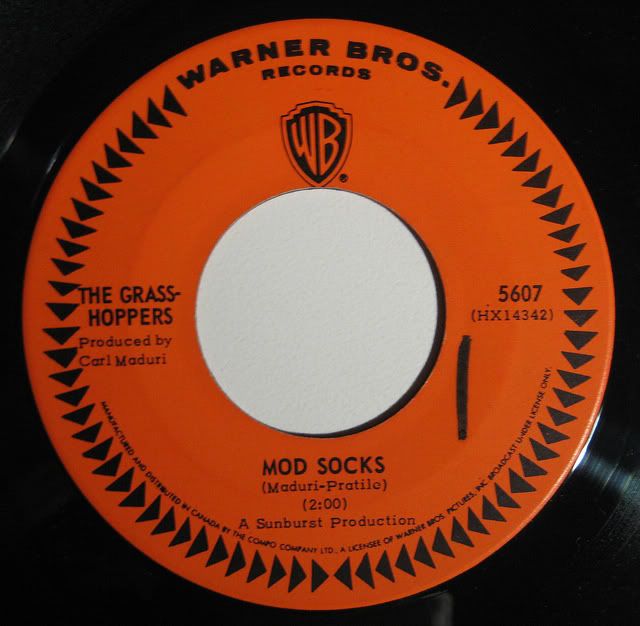 Jobling and Crowley argue that most young mods worked 9 to 5 at semi-skilled jobs, which
meant that they had much less leisure time and only a modest income to spend during their
time off.
Jobling and Crowley argue that most young mods worked 9 to 5 at semi-skilled jobs, which
meant that they had much less leisure time and only a modest income to spend during their
time off.
Amphetamines

A notable part of the mod subculture was recreational amphetamine use, which was used to
fuel all-night dances at clubs like Manchester's Twisted Wheel. Newspaper reports described
dancers emerging from clubs at 5 am with dilated pupils. Mods bought a combined
amphetamine/barbiturate called Drinamyl, which was nicknamed "purple hearts" from
dealers at clubs such as The Scene or The Discothèque. Due to this association with
amphetamines, Pete Meaden's "clean living" aphorism may be hard to understand in the
first decade of the 21st century. However, when mods used amphetamines in the pre-1964
period, the drug was still legal in Britain, and the mods used the drug for stimulation
and alertness, which they viewed as a very different goal from the intoxication caused
by other drugs and alcohol.
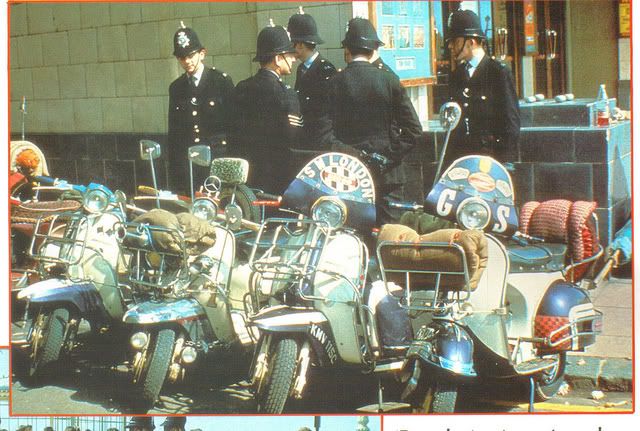 Mods viewed cannabis as a substance that would slow a person
down, and they viewed heavy drinking with condescension, associating it with the
bleary-eyed, staggering lower-class workers in pubs. Dick Hebdige claims that mods
used amphetamines to extend their leisure time into the early hours of the morning
and as a way of bridging the wide gap between their hostile and daunting everyday
work lives and the "inner world" of dancing and dressing up in their off-hours.
Mods viewed cannabis as a substance that would slow a person
down, and they viewed heavy drinking with condescension, associating it with the
bleary-eyed, staggering lower-class workers in pubs. Dick Hebdige claims that mods
used amphetamines to extend their leisure time into the early hours of the morning
and as a way of bridging the wide gap between their hostile and daunting everyday
work lives and the "inner world" of dancing and dressing up in their off-hours.
Dr. Andrew Wilson claims that for a significant minority, "amphetamines symbolised the
smart, on-the-ball, cool image" and that they sought "stimulation not intoxication...
greater awareness, not escape" and "confidence and articulacy" rather than the "drunken
rowdiness of previous generations."
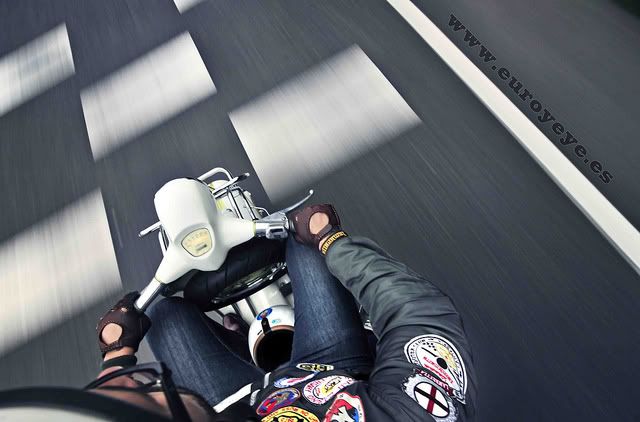 Wilson argues that the significance of amphetamines
to the mod culture was similar to the paramouncy of LSD and cannabis within the subsequent
hippie counterculture. The media was quick to associate mods' use of amphetamines with
violence in seaside towns, and by the mid-1960s, the British government criminalised
amphetamine use. The emerging hippie counterculture strongly criticised amphetamine
use; the poet Allen Ginsberg warned that amphetamine use can lead to a person becoming
a "Frankenstein speed freak."
Wilson argues that the significance of amphetamines
to the mod culture was similar to the paramouncy of LSD and cannabis within the subsequent
hippie counterculture. The media was quick to associate mods' use of amphetamines with
violence in seaside towns, and by the mid-1960s, the British government criminalised
amphetamine use. The emerging hippie counterculture strongly criticised amphetamine
use; the poet Allen Ginsberg warned that amphetamine use can lead to a person becoming
a "Frankenstein speed freak."
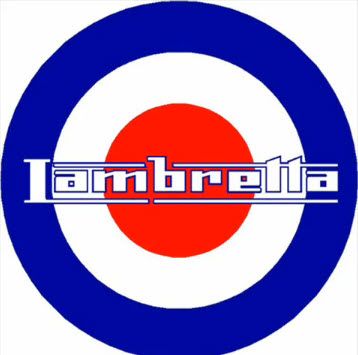
Scooters
Many mods used motorscooters for transportation, usually Vespas or Lambrettas. Scooters had provided inexpensive transportation for decades before the development of the mod subculture, but the mods stood out in the way that they treated the vehicle as a fashion accessory. Italian scooters were preferred due to their cleanlined, curving shapes and gleaming chrome. For young mods, Italian scooters were the "embodiment of continental style and a way to escape the working-class row houses of their upbringing". They customised their scooters by painting them in "two-tone and candyflake and over-accessorized [them] with luggage racks, crash bars, and scores of mirrors and fog lights", and they often put their names on the small windscreen. Engine side panels and front bumpers were taken to local electroplating workshops and recovered in highly reflective chrome.
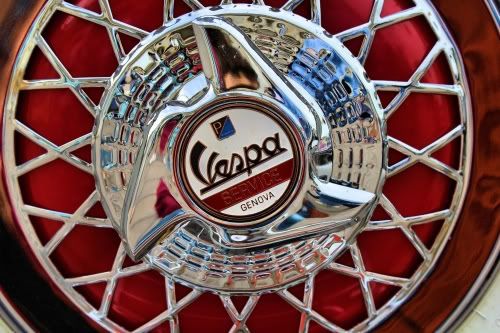
Scooters were also a practical and accessible form of transportation for 1960s
teens. In the early 1960s, public transport stopped relatively early in the night,
and so having scooters allowed mods to stay out all night at dance clubs. To keep
their expensive suits clean and keep warm while riding, mods often wore long army
parkas. For teens with low-end jobs, scooters were cheaper than cars, and they could
be bought on a payment plan through newly-available Hire purchase plans.
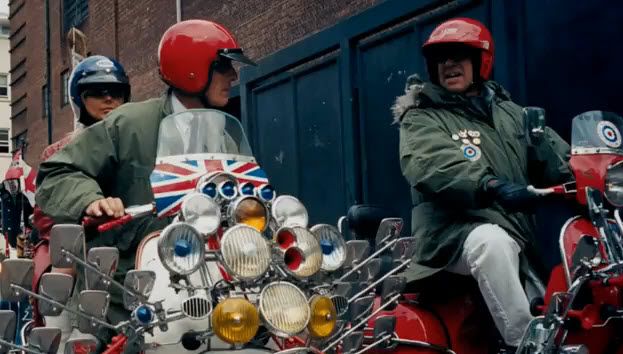
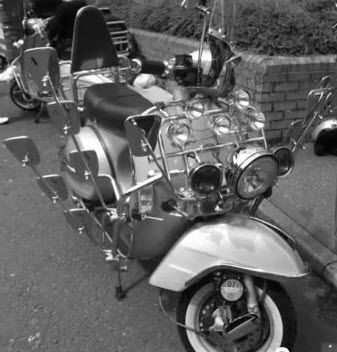 After a law
was passed requiring at least one mirror be attached to every motorcycle, mods were
known to add four, ten, or as many as 30 mirrors to their scooters. The cover of The
Who's album Quadrophenia, (which includes themes related to mods and rockers), depicts
a young man on a Vespa GS with four mirrors attached.
After a law
was passed requiring at least one mirror be attached to every motorcycle, mods were
known to add four, ten, or as many as 30 mirrors to their scooters. The cover of The
Who's album Quadrophenia, (which includes themes related to mods and rockers), depicts
a young man on a Vespa GS with four mirrors attached.
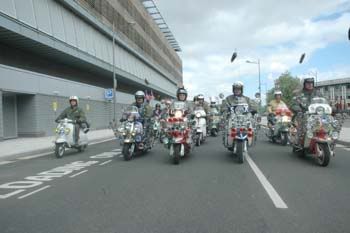
After the seaside resort brawls, the media began to associate Italian scooters with the image of violent mods. When groups of mods rode their scooters together, the media began to view it as a "menacing symbol of group solidarity" that was "converted into a weapon".
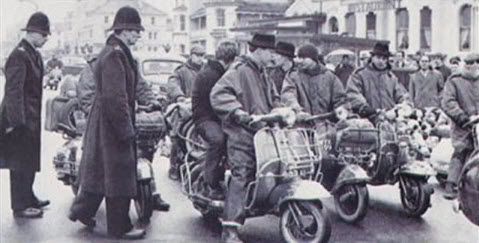
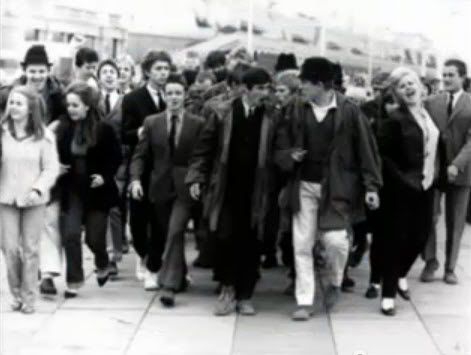
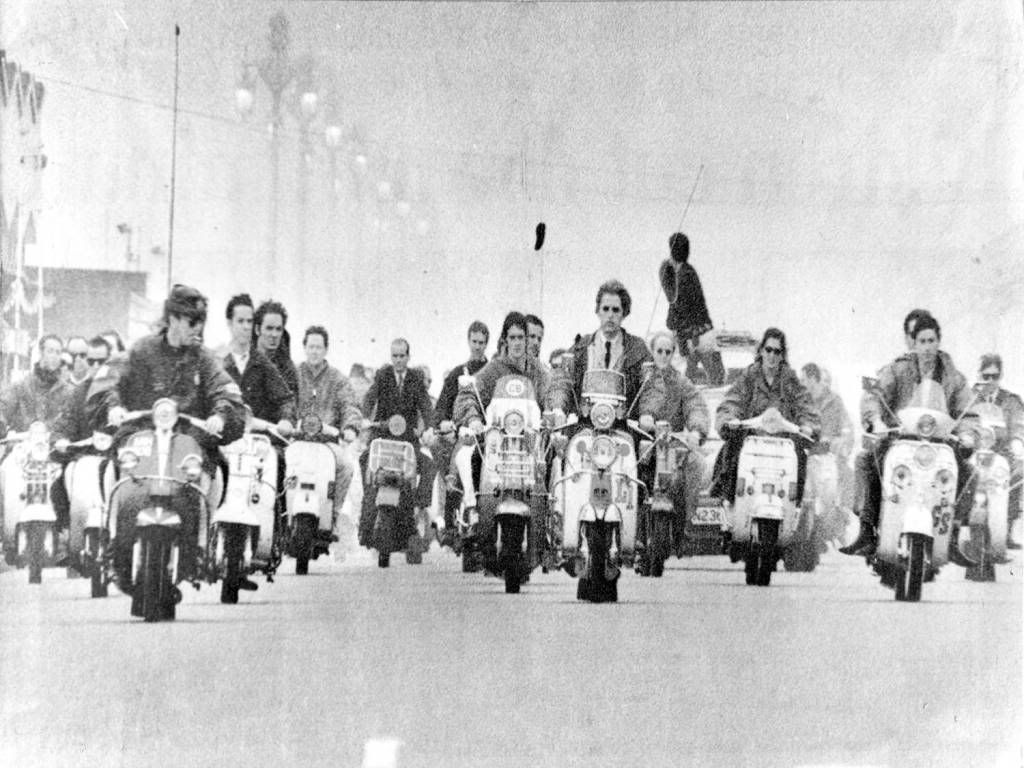
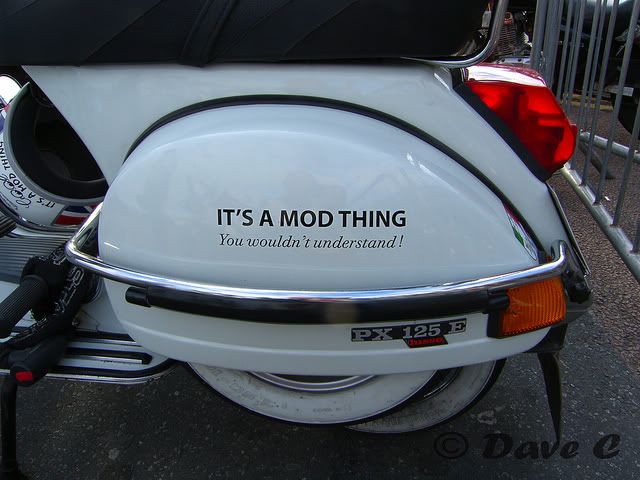
Gender Roles
In Stuart Hall and Tony Jefferson's study on youth subcultures in post-war Britain, they argue that compared with other youth subcultures, mod culture gave young women high visibility and relative autonomy. They claim that this status may have been related both to the attitudes of the mod young men, who accepted the idea that a young woman did not have to be attached to a man, and to the development of new occupations for young women, which gave them an income and made them more independent.
In particular, Hall and Jefferson note the increasing number of jobs in boutiques and women's clothing stores, which, while poorly paid and lacking opportunities for advancement, nevertheless gave young women disposable income, status and a glamorous sense of dressing up and going downtown to work. The presentable image of female mod fashion meant it was easier for young mod women to integrate with the non-subculture aspects of their lives (home, school and work) than for members of other subcultures. The emphasis on clothing and a stylised look for women demonstrated the "same fussiness for detail in clothes" as their male mod counterparts.
Shari Benstock and Suzanne Ferriss claim that the emphasis in the mod subculture on consumerism and shopping was the "ultimate affront to male working-class traditions" in the United Kingdom, because in the working-class tradition, shopping was usually done by women. They argue that British mods were "worshipping leisure and money... scorning the masculine world of hard work and honest labour" by spending their time listening to music, collecting records, socialising, and dancing at all-night clubs.
Conflicts With Rockers

As the Teddy Boy subculture faded in the early 1960s, it was replaced by two new youth subcultures: mods and rockers. While mods were seen as "effeminate, stuck-up, emulating the middle classes, aspiring to a competitive sophistication, snobbish, [and] phony", rockers were seen as "hopelessly naive, loutish, scruffy", emulating Marlon Brando's motorcycle gang leader character in the film The Wild One by wearing leather jackets and riding motorcycles. Dick Hebdige claims that the "mods rejected the rocker's crude conception of masculinity, the transparency of his motivations, his clumsiness"; the rockers viewed the vanity and obsession with clothes of the mods as not particularly masculine.
Scholars debate how much contact the two groups had during the 1960s; while Dick Hebdige argues that mods and rockers had very little contact, because they tended to come from different regions of England (mods from London and rockers from more rural areas), and because they had "totally disparate goals and lifestyles". However, British ethnographer Mark Gilman claims that both mods and rockers could be seen at football matches.
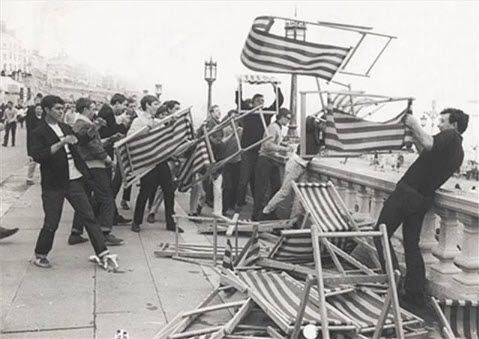
John Covach's Introduction to Rock and its History claims that in the United Kingdom, rockers were often engaged in brawls with mods. BBC News stories from May 1964 stated that mods and rockers were jailed after riots in seaside resort towns on the south coast of England, such as Margate, Brighton, Bournemouth and Clacton. The mods and rockers conflict led sociologist Stanley Cohen to coin the term moral panic in his study Folk Devils and Moral Panics, which examined media coverage of the mod and rocker riots in the 1960s. Although Cohen admits that mods and rockers had some fights in the mid-1960s, he argues that they were no different from the evening brawls that occurred between youths throughout the 1950s and early 1960s, both at seaside resorts and after football games. He claims that the British media turned the mod subculture into a negative symbol of delinquent and deviant status.
Newspapers described the mod and rocker clashes as being of "disastrous proportions", and labelled mods and rockers as "sawdust Caesars", "vermin" and "louts". Newspaper editorials fanned the flames of hysteria, such as a Birmingham Post editorial in May 1964, which warned that mods and rockers were "internal enemies" in the United Kingdom who would "bring about disintegration of a nation's character". The magazine Police Review argued that the mods and rockers' purported lack of respect for law and order could cause violence to "surge and flame like a forest fire".
Cohen argues that as media hysteria about knife-wielding, violent mods increased, the image of a fur-collared anorak and scooter would "stimulate hostile and punitive reactions" amongst readers. As a result of this media coverage, two British Members of Parliament travelled to the seaside areas to survey the damage, and MP Harold Gurden called for a resolution for intensified measures to control hooliganism. One of the prosecutors in the trial of some of the Clacton brawlers argued that mods and rockers were youths with no serious views, who lacked respect for law and order. Cohen says the media used possibly faked interviews with supposed rockers such as "Mick the Wild One". As well, the media would try to get mileage from accidents that were unrelated to mod-rocker violence, such as an accidental drowning of a youth, which got the headline "Mod Dead in Sea"
Eventually, when the media ran out of real fights to report, they would publish deceptive headlines, such as using a subheading "Violence", even when the article reported that there was no violence at all. Newspaper writers also began to use "free association" to link mods and rockers with various social issues, such as teen pregnancy, contraceptives, drug use, and violence.
A Mod's Point of View
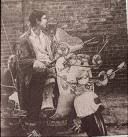
A good description and resource of Mods, Skinheads, Northern Soul etc via Scooters Galore Homepage
Mod is a subculture that originated in London, England in the late 1950s and peaked in the early to mid 1960s. Significant elements of the mod subculture include: fashion (often tailor-made suits); music, including African American Soul, Jamaican Ska, British Beat Music and R&B; and riding Italian motor scooters. From the mid to late 1960's onwards. The mod scene focus was in cafe/bars which would often be open until around 11pm AND where the jukeboxes would cater for their music tastes.
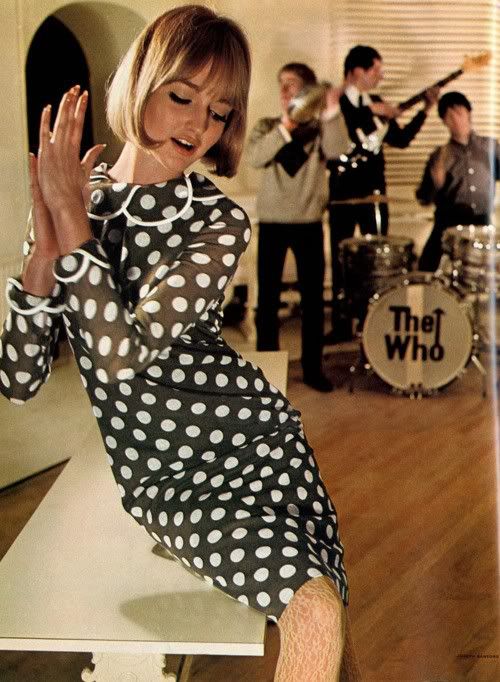
Skinheads were a subculture that originated among the British working
class youths in the late 1960s.
Named skinhead for their close-cropped
hair, the first skinheads were greatly influenced by the music (such record
labels as Trojan reggae) & Jamaican/West Indian rudeboy styles and also the
British mod scene, in terms of fashion, music & lifestyle. Skinheads (also
known as traditional skinheads or trads) are individuals who identify with
the original British skinhead subculture of the late 1960s, when ska, rocksteady,
reggae and soul music of that era were popular.
The phrase Spirit of '69 is used by traditional skinheads to commemorate what they identify as the skinhead subculture's heyday in 1969. The phrase was popularized by a group of Scottish skinheads called Glasgow Spy Kids. Its use in the title of a skinhead history book, Spirit of 69: A Skinhead Bible, led skinheads to adopt it around the world. The book was published in the early 1990s by the author George Marshall, a skinhead from Glasgow. In Spirit of '69: A Skinhead Bible, Marshall documents the origins and development of the skinhead subculture, describing elements such as music, dress, and politics in an attempt to refute many popular perceptions about skinheads; the most common being that they are all racists.
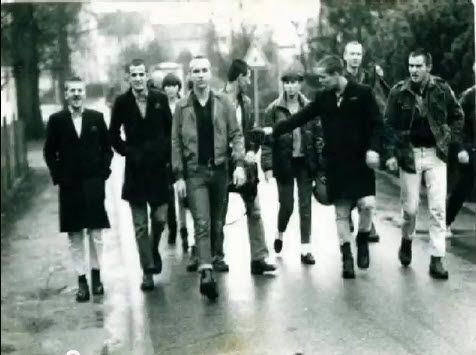
Because of their appreciation of music played by black people, they are non-racist, unlike the white power skinheads (a faction that developed in the later 1970s). Trad skinheads usually dress in a typical 1960s skinhead style, which includes items such as: Sta-press, button-down Ben Sherman shirts; Fred Perry polo shirts, braces, fitted suits, cardigan sweaters, sleeveless sweaters, Harrington jackets and Crombie-style overcoats. Hair is generally between a 2 and 4 grade clip-guard (short, but not bald), in contrast to the shorter-haired punk-influenced Oi! skins of the early 1980s.
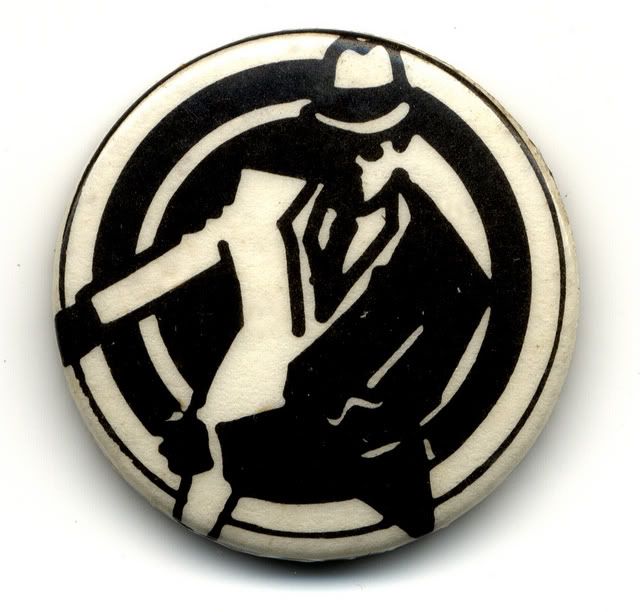
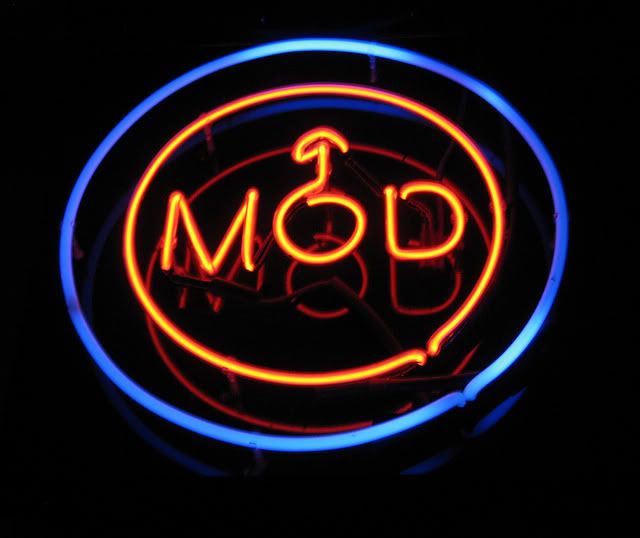
Northern Soul is a music & dance movement that emerged out of the British mod scene, initially in northern England in the late 1960s. Northern Soul mainly consists of a particular style of black American soul music based on heavy beat & fast tempo of the mid-1960s Tamla Motown sound. The Northern soul movement, however generally eschews Motown or Motown-influenced music that has met with significant mainstream success. The recordings most prized by genre enthusiasts are usually by lesser-known artists and were initially released only in limited numbers.
Northern soul is also associated with particular dance styles & fashions that grew out of the underground rhythm & soul scene of the 1960s, at venues such as the Twisted Wheel in Manchester. This scene quickly spread to other UK dancehalls & nightclubs like the Catacombs in Wolverhampton, the Highland Rooms in Blackpool Mecca, Golden Touch in Stoke-on-Trent& Wigan Casino. As favoured beat became more uptempo & frantic, by the early 1970s northern soul dancing became more athletic.Featuring spins, flips, & backdrops, club dancing styles were often inspired by the stage performances of visiting American soul acts such as Little Anthony & the Imperials & Jackie Wilson.
Soul boys were a working class English youth subculture of the late 1970s and early 1980s. Fans of American soul and funk music, it emerged in North-West England as northern soul event attendees began to take more interest in the more modern funk and jazz funk sounds of artists such Lonnie Liston Smith and Roy Ayers instead of obscure 1960s soul records that characterized the northern soul scene.
The subculture emerged at nightclubs in the South East England such as The Goldmine in Canvey Island and The Royalty in Southgate. DJs involved with the development of the soulboy scene included Chris Hill, Robbie Vincent, Greg Edwards and Froggy. Caister Soul Weekenders became the main event in the soulboy scene and still exist today. The casual subculture that emerged in the 1980s was heavily influenced by the soulboys, including the sideways fringed wedge hairstyle. Although the soulboy scene was huge by the early 1980s, it received little media coverage because it was centred around American funk acts and was largely working class. Therefore, it received far less coverage than more middle class youth cultures of the same period, notably the new romantics.

Scooterboy is a member of a specific subculture based around riding motor scooters namely Vespa and Lambretta Scooters. The subculture started in the late 1960s in the industrial north of England.The subculture resurfaced nationally in the United Kingdom around 1979 or 1980 at the time of the 2tone and mod revival.The huge number of scooter clubs that sprung up around this movement best identified as the scooterboy movement. Unlike the mods, who often customize their scooters with 1960s-style paint jobs and accessories (such as extra mirrors), scooterboys generally use a more modern style of paint work, sometimes adding murals depicting events or music, or in some cases turning them into cutdowns. Performance items were also added to the scooters to improve speed and handling.
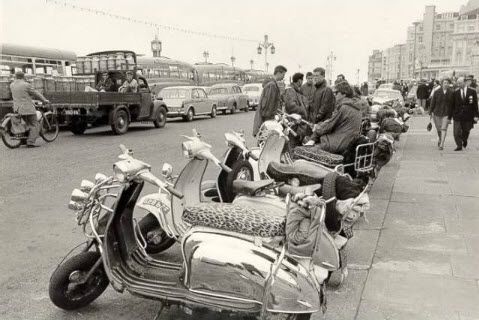
The high point for scooterboys in Great Britain was from 1984 to 1987.
Scooter rallies during this period were attracting numbers in excess of
10,000 or 15,000 people. Scooter rallies usually involved camping, allnighters
and alldayers, watching bands, dancing to DJs, drinking and participating in
various scooter-related activities. In the 1980s, scooterboys listened to
various styles of music, including ska, 2 Tone, psychobilly, punk rock, Oi,
and Northern Soul.
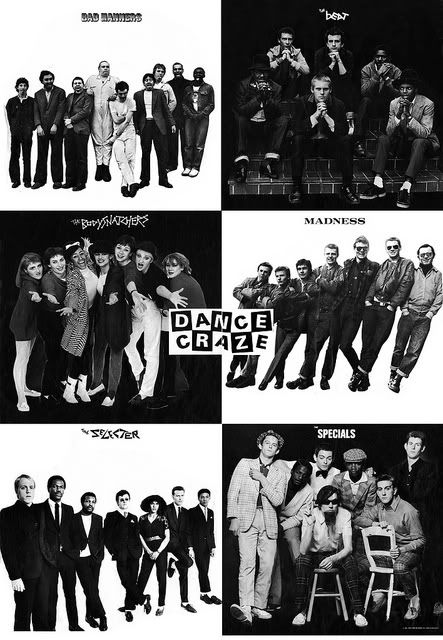
A few popular songs at scooter rallies in the 1980s included:
The Snake by Al Wilson, Should I Stay Or Should I Go? by The Clash,
Skinhead Love Affair by Bad Manners, Surfin Bird by The Trashmen,
and Tony Blackburn by Binky Baker.
The scooterboy subculture has spread around the world, largely due to magazines such as Scootering and Scooter Scene. In the 2000s, there has been a sizable scooterboy (or as they are now known, scooterist) scene in many countries, notably Germany, the United States, France and Italy.
And that ends part one
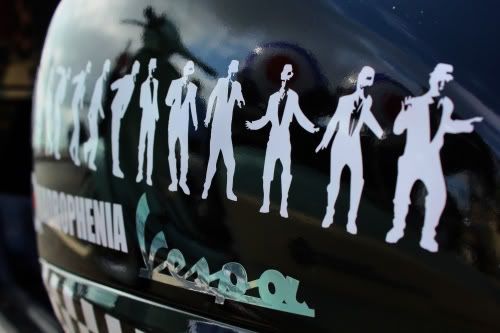

No comments:
Post a Comment